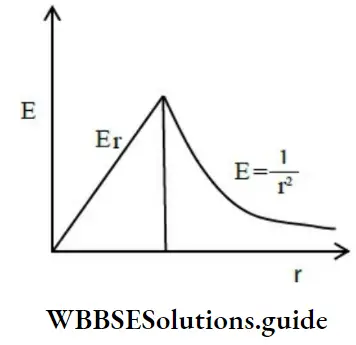Electric Charges And Fields
Some Basics Of Electric Charge
- S.I. Unit of charge is coulomb (C).
- Dimensional formula [Q] = [AT]
- The process of sharing charges with the earth is called grounding or earthing.
- When we rub two insulating objects against each other, we provide energy to overcome friction between the objects.
- This energy is used to remove the electrons from one object and transfer them to other.
- The electrons are removed from the object where they are less tightly held and transferred to the object where they are tightly held.
- The object losing electrons becomes positively charged and the object gaining electrons will become negatively charged.
- For example, when glass rod is rubbed with silk, some of the electrons are transferred from the glass rod to the silk cloth.
- Thus, the rod gets positively charged and silk cloth gets negatively charged. No new charge is created during rubbing.
- The number of electrons that are transferred is a very small fraction of the total number of electrons in the material body.
Concept of Electric Field Lines and Flux for NEET Physics
The substances which allow electric charges to pass through them easily are called conductors. The substances which do not allow electrical charges to pass through them easily are called insulators.
Read And Learn More: NEET Physics Notes
- When some charge is transferred to a conductor, it readily gets distributed over the entire outer surface of the conductor.
- Due to mutual repulsion between like charges, they always remain on the outer surface of the conductor.
- Distribution of charge on the surface of the conductor depends upon the shape of the conductor.
If some charge is put on an insulator, the charge stays at the same place. - In other words, the charges remain localised on an insulator.
- 6.25 x1018 electrons constitute one coulomb of charge in magnitude.
- When ‘n’ electrons are removed from a body, charge on the body will be +ne.
- When ‘n’ electrons are added to a body charge on the body will be -ne.
Properties Of Charges
If a system has charges q1, q2, . . . . . qn the total charge of the system is given by the algebraic sum.
∴ qnet = q1 + q2 + . . . . + qn
i.e., charges are additive in nature.
- Total charge on an isolated system is constant. (charge is neither be created, nor be destroyed) i.e., charge is conserved.
- Charge on a body should be integral multiple of ‘e’. i.e., charge is quantised, q = ± ne, n = 0, 1, 2, . . . .
- Like charges repel each other, and opposite charges attract each other.
- Accelerated charges radiate energy in the form of electromagnetic waves.
- Charge is a scalar quantity
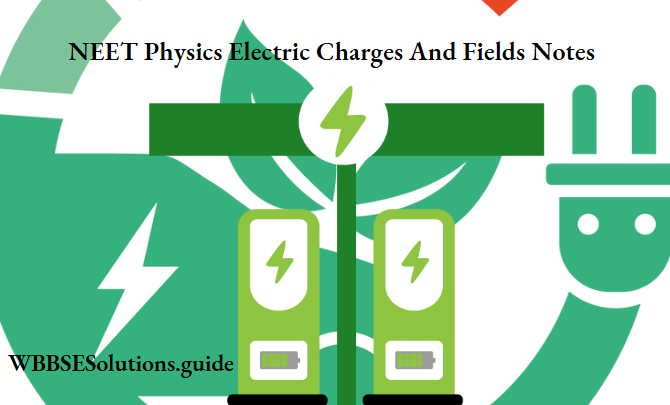
Electric Charges and Fields NEET Important Questions
Coulomb’s Law
The force of attraction or repulsion between two point charges is directly proportional to product of magnitudes of charges and is inversely proportional to square of the distance between them, and this force acts along the line joining the two charges.
Difference Between Conductors and Insulators NEET Questions
⇒ \(\text { i.e., } F-k \frac{q_1 q_2}{r^2}\)
⇒ \(\text { where, } \mathrm{k}=\frac{1}{4 \pi \mathrm{r}_9}-9 \times 10^7 \mathrm{Nm}^2 \mathrm{C}^{-2},\)
⇒ \(\varepsilon_0=8.854 \times 10^{-12} \mathrm{~N}^{-1} \mathrm{~m}^{-2} \mathrm{C}^2\)
⇒ \(\varepsilon_0\) is called the absolute permittivity of free space.
⇒ \(\left[\mathrm{E}_0\right]=\left[\mathrm{ML}^{-1} \mathrm{~T}^{-1} \mathrm{~A}^2\right]\)
Dielectric constant (K) or relative permittivity \(\varepsilon_r\)
K = \(\varepsilon_f=\frac{\mathbf{F}_{\text {air } / \text { racuum }}}{\mathbf{F}_{\text {medium }}}\)
Electric Field Or Electric Field Intensity
Electric field at a point in space is the force experienced by a unit positive charge when placed at that point.
i e., \(\overrightarrow{\mathrm{E}}-\frac{\overrightarrow{\mathrm{F}}}{\mathrm{q}}\)
S.I. Unit of I is Nm-1 or Vm-1
Electric field lines due to Isolated positive point charge.
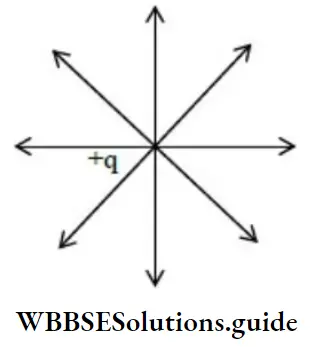
Electric field lines due to isolated Negative point charge.
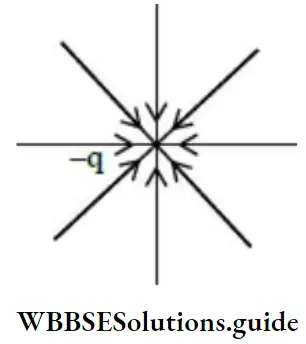
Properties of Electric Field Lines
- They always start from positive charge and end at negative charge.
- (In a charge free region, electric field lines start from positive charge and end at infinity and they start from infinity and end at negative charge)
- They do not form closed loops
- They never intersect each other (if they intersect, at the point of intersection there will be two directions for the electric field, which is not possible.)
- The tangent drawn at any point on an electric field line will give its direction at that point.
- Electric lines are always perpendicular to the surface of a condutor (irrespective of its shape)
- Crowded electric field lines indicate stronger electric field.
Electric Flux
Electric flux through an area is a measure of number of electric field lines passing through that area.
⇒ \(\phi_E=\overrightarrow{\mathrm{E}} \cdot \overrightarrow{\mathrm{A}}=\mathrm{EA} \cos \theta .\)
Electric flux is a scalar quantity.
Dimensions of electric flux \(\left[\phi_E\right]=\left[\mathbb{L}^3 \mathrm{~T}^{-3} \mathrm{~A}^{-1}\right]\)
A neutral point is a point where resultant electric field is zero.
Force experienced by a charged particle q when it is placed in a uniform electric field E is given by
⇒ \(\mathrm{F}=\mathrm{qE}\left(because \mathrm{E}=\frac{\mathrm{F}}{\mathrm{q}}\right)\)
Tricks to Solve Electric Charges and Fields Problems for NEET
∴ The acceleration of the charge is, \(\mathrm{a}=\frac{\mathrm{F}}{\mathrm{m}} \Rightarrow \mathrm{a}=\frac{\mathrm{qE}}{\mathrm{m}}\)
Velocity acquired by a charged particle starting from rest in time ‘t’ is given by \(\mathrm{v}=\mathrm{u}+\mathrm{at} \Rightarrow \mathrm{v}=\frac{\mathrm{qE}}{\mathrm{m}} \mathrm{t}\)
Momentum of the charged particle is given by, \(\mathrm{p}=\mathrm{mv}=\mathrm{m} \frac{\mathrm{qEt}}{\mathrm{m}}\)
∴ p =qEt
Kinetic energy gained by the charged particle in time ‘t’ is \(\mathrm{K}=\frac{1}{2} m v^2=\frac{1}{2} \mathrm{~m}\left(\frac{\mathrm{q}^2 \mathrm{E}^2 \mathrm{t}^2}{\mathrm{~m}^2}\right)\)
∴ \(\mathrm{K}=\frac{\mathrm{q}^2 \mathrm{E}^2 \mathrm{t}^2}{2 \mathrm{~m}}\)
Kinetic energy gained by the charged particle in travelling a distance y in the direction of uniform electric field is
⇒ \(v^2=u^2+2 a y\)
⇒ \(v^2=2 a y \quad(because u=0)\)
K = \(\frac{1}{2} m v^2=\frac{1}{2} m(2 a y)=m\left(\frac{q E}{m}\right) y \quad\left(because a=\frac{q E}{m}\right)\)
∴ K = qEy
Electric Dipole
A pair of equal and opposite charges separated by a small distance.
Electric dipole moment: It is a vector, whose magnitude is equal to product of either charge and separation between the two charges. The direction of electric dipole moment is from negative to positive charge.
⇒ \(\overrightarrow{\mathrm{p}}=\mathrm{q} \times 2 \mathrm{a} \dot{\mathrm{p}}\)
⇒ \(|p|-p=(q) 2 a\)
Coulomb’s Law and Gauss’s Theorem NEET Questions with Solutions
Axial electric field due to a dipole:
⇒ \(\overrightarrow{\mathrm{E}}_{\mathrm{u}}=\frac{1}{4 \pi \varepsilon_0} \frac{2 p r}{\left(\mathrm{r}^2-\mathrm{a}^2\right)^2} \overrightarrow{\mathrm{p}}\)
If a < < r, then
⇒ \(\overrightarrow{\mathrm{E}}_{\mathrm{a}}=\frac{12 \mathrm{p}}{4 \pi r_0 \mathrm{r}^3} \dot{\mathrm{p}}\)
Equatorial Field Due to a Dipole
⇒ \(\vec{E}_{e q}=-\frac{1}{4 \pi r_0} \frac{p}{\left(r^2+a^2\right)^{\frac{3}{2}}} \dot{p}\)
If a << r, then
⇒ \(\overrightarrow{\mathrm{E}}_{\bar{q}}=-\frac{1}{4 \pi \varepsilon_n} \frac{\mathrm{p}}{\mathrm{p}} \hat{\mathrm{p}}\)
Relation between axial and equatorial electric fields
⇒ \(\left|\overrightarrow{\mathrm{E}}_{\mathrm{xx}}\right|=2\left|\overrightarrow{\mathrm{E}}_{\text {cas }}\right|\)
The electric field at any point around a dipole is given by,
E = \(\left[\frac{1}{4 \pi \delta_0} \frac{p}{r^3}\right] \sqrt{3 \cos ^2 \theta+1}\)
When an electric dipole is placed in a uniform electric field E, then the torque experienced by it is given by,
⇒ \(\vec{\tau}=\vec{P} \times \vec{E}\)
⇒ \(\tau=P E \sin \theta\)
Gauss’s law
The total electric flux through a closed surface in air is equal to \(\frac{1}{\varepsilon_0}\) times the total charge enclosed by the surface.
⇒ \(\phi_{\mathrm{E}}=\frac{1}{\mathrm{~s}_0}\left(\mathrm{q}_{\mathrm{DEt}}\right)\)
Electric field due to infinite long straight charged conductor,
E = \(=\frac{\lambda}{2 \pi E_0 r}\)
If the conductor is of finite length then
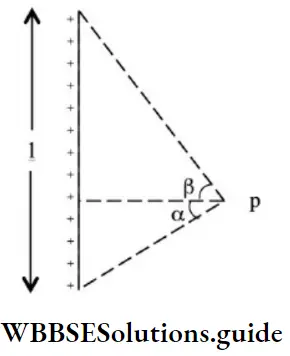
NCERT Summary of Electric Charges and Fields for NEET
where r is the perpendicular distance between the conductor and the point P.
Electric field on the axis of a charged circular ring carrying charge Q.
E = \(\frac{1}{4 \pi \varepsilon_0} \frac{Q x}{\left(R^2+x^2\right)^{\frac{3}{2}}}\)
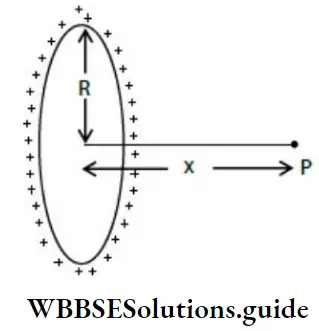
- When x = 0, E = 0
- x » R, then, E = \(\frac{1}{4 \pi E_0} \frac{Q}{x^2}\)
Electric field due to infinitely long plane sheet of charge E = \(\frac{\sigma}{2 \varepsilon_0}\)
Where ‘ σ ’ is surface charge density (charge per unit area)
Note: Electric field due to an infinite plane sheet of charge is independent of distance.
Electric field due to a charged conducting shell
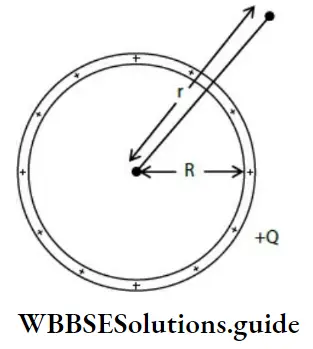
1. At a point outside the shell \(E_{out}=\frac{1}{4 \pi x_v} \frac{Q}{r^2}\)
2. At a point on the surface of the shell \(E_{\text {Sur}}=\frac{1}{4 \pi \varepsilon_0} \frac{Q}{R^2}=\frac{1}{4 \pi \varepsilon_0} \frac{\sigma\left(4 \pi R^2\right)}{R^2} \quad\left[\sigma=\frac{Q}{4 \pi R^2}\right]\)
⇒ \(E_{\text {Sur}}=\frac{\sigma}{\varepsilon_0}\)
3. At a point inside the shell Ein = 0
Chapter-wise Weightage for NEET Physics Electric Charges and Fields
Electric field due to a charged conducting sphere
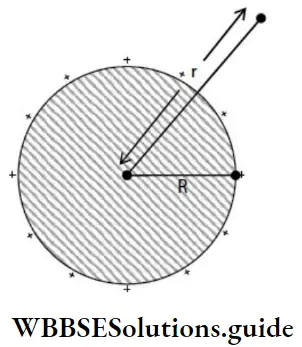
⇒ \(\mathrm{E}_{\text {out }}=\frac{1}{4 \pi \varepsilon_0} \frac{\mathrm{Q}}{\mathrm{r}^2}\)\
⇒ \(\mathrm{E}_{\mathrm{Sur}}=\frac{\sigma}{\varepsilon_0}\)
⇒ \(\mathrm{E}_{\text {in}}=0\)
Electric field due to a uniformly charged non-conducting sphere (or uniform spherical cloud of charge)
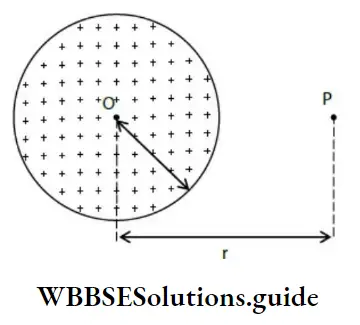
⇒ \(E_{\text {outside }}=\frac{1 \cdot Q}{4 \pi \varepsilon_4 r^2}\)
⇒ \(E_{\text {Surface }}=\frac{1}{4 \pi r_0} \frac{Q}{R^2}\)
⇒ \(E_in=\frac{1}{4 \pi \varepsilon_0 R^3}\)
where r is the distance from the center
Step-by-Step Solutions for Electric Charges NEET Problems
Variation of \(\overrightarrow{\mathrm{E}} \) with distance (r)
